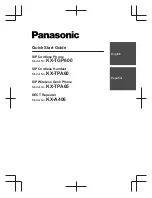
T A L K S W I T C H C O N F I G U R A T I O N
153
AUTO ATTENDANTS (MENUS)
An auto attendant can answer a telephone line or VoIP number, and can be included in the call
cascade of a local extension, remote extension or ring group.
An auto attendant can answer a call if the receptionist is away or if you don’t have a
receptionist. Each auto attendant has a message and up to six options. The message tells the
caller what the options are. You can load a professionally pre-recorded message, or can record a
message using a handset. The caller selects an option by dialing
0
(
9
in some regions),
1
,
2
,
3
,
4
or
5
. The auto attendant then performs the action programmed for the option. The auto
attendant can:
•
Transfer the call to a local extension, remote extension or ring group. The call then follows
the extension’s call cascade.
•
Transfer the call to the call queue of a ring group. The call is placed on hold. The TalkSwitch
system will ring the next available local extension in the ring group.
•
Transfer the call to a voice mailbox, allowing the caller to leave a message. The call can be
transferred to a local extension, remote extension or general voice mailbox. Pressing
*
during the greeting returns to the auto attendant. If the
0
option is programmed (
9
in some
regions), pressing
0
during the greeting (
9
in some regions) can route the call to an
extension, voice mailbox, announcement or auto attendant. An authorized caller can
retrieve messages and perform other voicemail activities by pressing
8
during the greeting.
If no digit is pressed during the greeting, the system hangs up after the caller leaves a
message.
•
Play an announcement with directions, business hours, etc. The announcement can have the
0
option programmed (
9
in some regions) to route the call to an extension, voice mailbox,
announcement or auto attendant. The system hangs up after the announcement if no digit
is dialed. Pressing
*
returns to the auto attendant.
•
Access the dial-by-name directory so the caller can find a user’s extension number. The dial-
by-name directory prompts the caller to enter the first three letters of the user’s last name.
Pressing
*
returns to the auto attendant. See
Setting up the dial-by-name directory
on page
158.
•
Route the call to another auto attendant, which allows actions to be nested into a powerful
call routing system. For example, the main auto attendant can say
“Press one for English.
Oprima dos para Español.”
Option 1 goes to the English auto attendant and option 2 goes to
the Spanish auto attendant.
In addition to the six auto attendant options, the caller can:
•
Reach an extension by dialing an extension number.
•
Access voicemail by pressing
**
then the mailbox number.
•
Access call back by dialing
6
.
•
Access call bridge/DISA by dialing a hunt group number.
•
Enter command mode by pressing
#
.
The caller is able to dial an extension, even if the first number of the extension is the same as
an auto attendant option. For example, the caller can dial
111
even though the first “1” is the
same as auto attendant option 1. This is because the TalkSwitch system waits after the caller
dials a digit, before following the action for that digit. The default wait time is 1.5 seconds, and
is set with the
Single digit fall through time
list in the
Auto Attendants
window.
















































